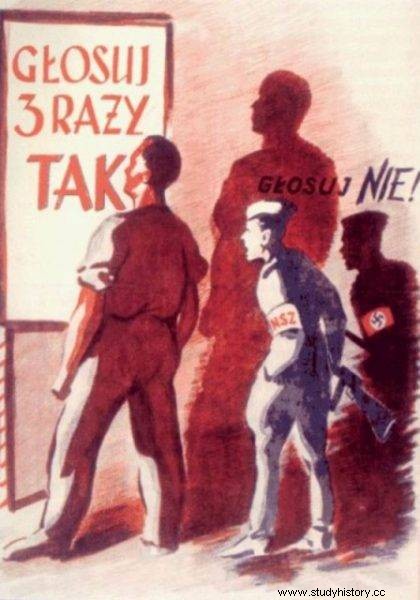As Joseph Stalin used to say:"It doesn't matter who votes, it matters who counts the votes." According to this maxim, on June 30, 1946, a people's referendum was held in Poland. What was the purpose of this previously unplanned plebiscite?
In June 1946, the communist authorities asked the Poles three questions:
1) Are you in favor of abolishing the Senate?
2) Do you want to consolidate in the future constitution the economic system introduced by the land reform and nationalization of the basic branches of the national economy while maintaining the statutory rights of private initiative?
3) Do you want to consolidate the western borders of the Polish State on the Baltic, Odra and Nysa Łużycka?
What did they need this referendum for - especially with such obvious questions?
Appearances of a democratic state
The Yalta agreements guaranteed a multi-party system in Poland, so all democratic and anti-fascist parties were to participate in the parliamentary elections.
So the most important thing was the future elections. However, the communists were not ready for them and wanted to delay as long as possible. The referendum was supposed to help them with this. Moreover, they were fully aware that a large part of the society disliked them, therefore they feared failure.
In this context, the people's referendum was to be a kind of test, and at the same time ... a lesson in manipulating the voting results.

3 x yes propaganda board
From the very beginning, the communist authorities of the Polish people operated in two ways. On the one hand, they shaped the apparent reality, trying to build broader political platforms, gain authorities, people with well-known names. At that time, there was still a multi-party system and a democratic electoral law. Bierut participated in the Corpus Christi procession. It was supposed to create the appearance of a sovereign and democratic state.
The second course of action was to subordinate the army, security apparatus and industry to the communists, as well as to unleash the machine of terror. Communist agents took over democratic parties, social and political organizations.
"Pole sign 3 times yes!"
The content of the referendum questions was to check the opposition, which ... would also most willingly call for voting "yes" three times. In this context, it was decided to call for a vote on the first question "no".
Preparations for the referendum began with a massive propaganda campaign. The propaganda materials were even dropped from airplanes. Slogans such as "Pole sign 3 times yes!" they shouted from almost every wall.
Opposition politicians were harassed and intimidated at the same time, including putting them in custody for fanciful reasons. Before the vote, the district public security offices, at the request of the ministry, prepared special lists of people who were to be arrested "preventively."
Big spoof
All this, however, might not be enough, so prepared for a massive fake. An outstanding expert in this field, Colonel Aron Pałkin, head of the Ministry of State Security of the Soviet Union, dealing with expert opinions and forging documents, came to the rescue. A group of Soviet security service officers delegated to "handle" the referendum worked until the end of August.

A propaganda poster from 1946 - Referendum 3 x YES. Behind the reader, a soldier of the NSZ, presented as a Nazi collaborator, urging people to vote NO
In the polling stations themselves, the possibility of falsifying votes was difficult, because representatives of the PSL, the party constituting the backbone of the opposition, sat on the committees and as stewards. However, the successive stages of the electoral procedure - district and precinct electoral commissions - were already completely taken over by the communists. Thus, the right decisions were practically taken in the committees of the Polish Workers' Party (PPR) and the security offices.
According to the official results , 11,857,968 people took part in the referendum, which was 90.1% of the eligible voters. The first question "yes" was to be answered by 68% of voters, the second - 77.2%, and the third - 91.4%. These results were drastically different from the actual data disclosed in the 1990s.
In fact, the first question of the referendum was answered "yes" by only 26.9% of voters, the second - 42%, and the third - 66.9%. The answer "3 times yes" was given by only 26.9% of voters.
Communists, enriched with referendum experiences, started preparations for the elections. The scale of repression and surveillance this time was supposed to be much larger ...
